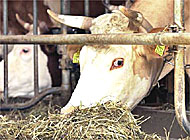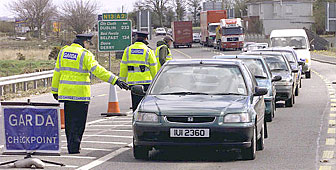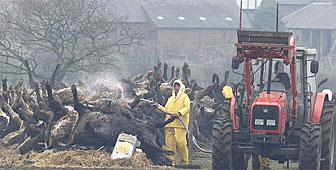Swiss test defences against foot-and-mouth

Switzerland may be free of foot-and-mouth disease, but veterinary experts are warning that the highly contagious virus could strike at any time.
Two years ago, six million animals were slaughtered in Britain, in the worst outbreak of foot-and-mouth seen in Europe.
The disease continues to rage in 70 countries and can be introduced by any traveller who has been in contact with contaminated farms or through the importation of infected meat.
Soon after contact with foot-and-mouth, whole herds of ruminants and swine become infected, though only two to five per cent actually die from the disease.
But the disease is feared because it spreads rapidly, leading to long-term, devastating economic losses. Containment is paramount once the virus has been confirmed.
Preparing for the worst
The Swiss authorities responsible for dealing with such an outbreak recently tested their contingency plans in a two-day simulation exercise – the first ever staged in the country.
The operation involved the Federal Veterinary Office, the Swiss National Reference Laboratory for Exotic Diseases, civil protection units, farmers, police, fire brigade teams and vets from cantons Friburg, Vaud, Valais and Neuchâtel.
It took eight months to plan and cost SFr50,000 ($38,500) to execute – a drop in the ocean compared with the real costs of an outbreak.
In Britain, the financial damage to agriculture and the food industry has been estimated at over £3 billion (SFr6.69 billion).
Crisis scenario
The simulation was based on a scenario that the authorities believe could happen at any time: a farmer returns from southeast Asia with contaminated meat, which comes into contact with his own pig holding; a vet is called and swabs taken; these are then sent to the national laboratory for exotic diseases, which confirms an outbreak.
By now it is too late to stop the virus spreading to 16 other farms, where it is carried by the wind or livestock.
More than 3,000 cattle, sheep, pigs and goats have to be destroyed and their bodies disposed of.
Vets, police, firemen and civil protection officers help to cordon off the infected farms, disinfect the premises and slaughter the diseased animals. The Veterinary Office imposes a nationwide ban on the transportation of all livestock.
Switzerland has 300,000 doses of emergency vaccine ready for this particular type of foot-and-mouth virus.
Vaccinating an animal does not prevent it from becoming infected with the disease or even becoming a carrier.
But, according to Christian Griot, director of the national laboratory for exotic diseases, vaccination can stop animals that produce vast amounts of the virus from releasing it into the air.
Efficient response
On the whole, the heads of participating organisations were impressed with the efficiency of the authorities’ response.
Most agreed that the hardware needed to tackle such an outbreak was in place. But Griot believes the exercise exposed slow coordination between key players.
This could be addressed, he suggests, by drawing up guidelines to better define areas of responsibility, and designating mediators between different agencies.
Pierre-François Gobat, head of the Cantonal Veterinary Association, said the exercise also highlighted a worrying manpower problem.
The majority of graduates from veterinary schools prefer to work in higher paid pet practices than with large animals, so there are not enough farm vets to deal with a large scale emergency.
In the event of an outbreak, retired farm vets would have to be deployed and vets enlisted from neighbouring countries.
Griot points out that the authorities are also facing an ongoing battle to increase vigilance among Swiss farmers.
The last outbreak of foot-and-mouth in Switzerland was more than 20 years ago, and the disease no longer strikes the same fear into many farmers.
Awareness campaign
The Veterinary Office has responded by publishing articles about the threat of foot-and-mouth and other diseases in periodicals and newspapers read by the farming community.
And as a result of Britain’s foot-and-mouth crisis, the national laboratory for exotic diseases has dramatically increased the rate at which it can analyse suspect samples. National contingency planning has also been improved.
The simulation exercise was also aimed at persuading politicians to make sufficient funding available to deal with a foot-and-mouth outbreak.
“If the politicians don’t take the threat seriously, they could face the kind of devastation witnessed in Britain. Agricultural production in this country would be crippled,” warned Griot.
swissinfo, Julie Hunt
The Swiss authorities have been testing their ability to respond to an outbreak of foot-and-mouth disease.
Following the two-day operation, they reported back on their strengths and weaknesses.
The last major outbreak of foot-and-mouth in Switzerland was in 1965/66.
Vaccination of cloven-hoofed animals was discontinued in 1990.
The Swiss cattle population of 1.8 million animals, as well as pigs, sheep and goats, would be at risk from an outbreak.
The incubation period is from one to seven days, during which time infected animals are highly contagious.
Humans are rarely infected, but can spread the virus

In compliance with the JTI standards
More: SWI swissinfo.ch certified by the Journalism Trust Initiative




You can find an overview of ongoing debates with our journalists here . Please join us!
If you want to start a conversation about a topic raised in this article or want to report factual errors, email us at english@swissinfo.ch.